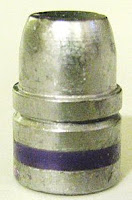Wadcutters:
Was asked about this, and basically could not think of the correct terms to use. I used the term casing when I should have used lubrication and bands.
Here is a better way of describing them.
Wadcutter: A wadcutter has a flat or nearly flat front that is typically as wide as the caliber size or only slightly smaller in diameter than caliber size. For target shooting, a wadcutter cuts a very clean hole through the paper target, making it easier to score and ideally reducing errors in scoring the target in the favor of the shooter.[1] Because the flat nosed bullet is not well suited for feeding out of a magazine, wadcutters are normally used only in revolvers or in specially designed semi-automatic pistols, although this is not always the case as some wadcutters may have rounded bullet nose profiles. All lead wadcutters require proper lubrication to prevent leading of rifling and forcing cones when used in firearms.
Semiwadcutter: A semiwadcutter or SWC is a type of all-purpose bullet commonly used in revolvers. The SWC combines features of the wadcutter target bullet and traditional round nosed revolver bullets and is used in both revolver and pistol cartridges for hunting, target shooting, and plinking. Originally Keith specified a meplat that was 65% of the bullet caliber but later increased it to a 70% meplat. The other distinguishing characteristics of a "Keith-style" SWC are a double radius ogive, beveled crimp groove, three equal width driving bands, wide square bottomed grease groove, and a plain base with sharp corners. The wide forward driving band helps keep the bullet aligned as it jumps across the cylinder gap. Because of the three wide equal width driving bands, the total bearing surface is greater than half the overall length of the bullet. This large bearing surface helps the Keith-style SWC to be an inherently accurate bullet and minimizes leading from gas blow-by. The wide square bottom grease groove holds ample lubricant.


No comments:
Post a Comment